Shorter days and cooler nights bring changes as the daytime temperatures vary between hot and mild. With the dryer air the sunshine has a golden clarity enhancing the colourful winter flowers and mellow berries, and brightening the visiting birds and insects in the garden.
I am always surprised to notice that few gardens in our neighbourhood host the cheerful wild dagga (Leonotis leonurus) that flowers in autumn and early winter and attracts colourful sunbirds that come to visit the nectar-laden flowers. Clusters of flowers are spaced out along long stems and they bloom successively, which increases its flowering time that lasts for several months.
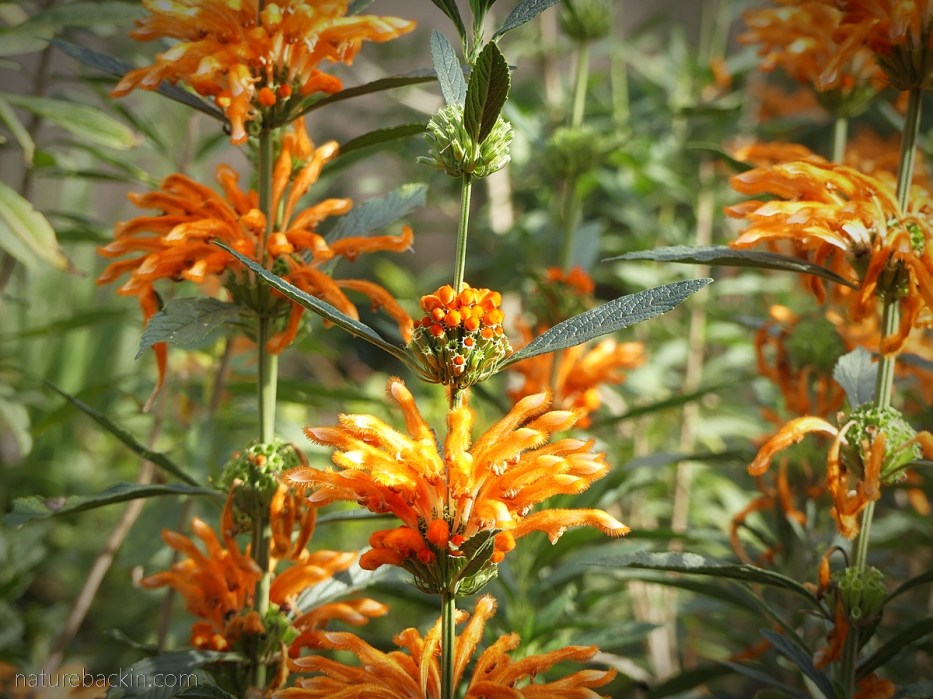
Added to the cheerful orange colour, beautiful form and long flowering period, the leaves and flowers have an interesting herby smell when crushed. The common name, wild dagga, derives from the fact that dried leaves and flowers can be used as a kind of tobacco and may provide a mild euphoric effect when smoked. In the book People’s Plants by Ben-Erik van Wyk and Nigel Gericke (Briza, 2007) it is reported that the smoke is acrid and so it is best smoked through a water-pipe. In addition to being used as a tobacco, the plant has also been used traditionally in a variety of medicines.
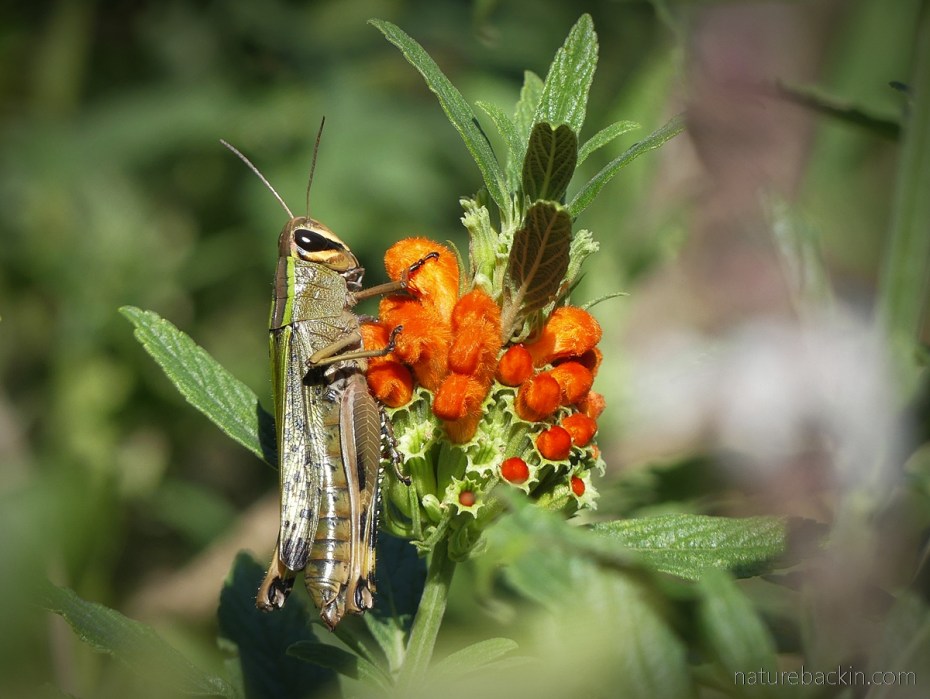
It is not just sunbirds attracted to the wild dagga flowers. I spotted this grasshopper sunning itself on a cluster of budding flowers. I have noticed grasshoppers nibbling on the leaves of wild dagga plants from time to time.
In addition to flowers, leaves and seeds, the plants in the garden also provide food for birds and other creatures in the form of berries, which are highly valued.

Several species of birds and also vervet monkeys feed on the fruits of the tassel-berry tree (Antidesma venosum). The popularity of the fruit, as can be seen in the above photo, is evident from the bare stems showing that many of the fruits have been picked from what was previously a dense cluster of tassels bearing fruits. For more about this lovely tree see this previous post.

The fruits of the cross-berry (Grewia occidentalis) are also sought after, particular by vervet monkeys who spend time in the small trees carefully selecting and picking berries to their taste. The cross-berry is a host plant for processionary caterpillars, which I have written about here.

Also fruiting during the months of winter is the Solanum giganteum sporting vivid scarlet berries. I have not ever seen monkeys eating these berries but the berries do seem to be favoured mostly by dark-capped and sombre bulbuls and Cape white-eyes.

A bronze mannikin took time off from searching for seeds to pose on a branch next to a forest-pink hibiscus flower while I lurked behind a nearby shrub in the hope of snapping this photo without frightening off the wary bird.

And here is a close-up of a flower of the forest pink hibiscus bedecked with droplets after a recent shower of rain. The plants are still producing a few flowers as the season progresses into winter.

Not really pink but definitely of a rosy hue, this hybrid Barberton daisy is also glistening with rain drops on a recent morning. The rains are fading as we enter our dry season, but an approaching cold front will bring to our region brief showers and much colder temperatures this weekend.

This morning, after seeing a brownhooded kingfisher diving down from a tree branch to catch an insect on the ground I went inside to fetch my camera. As I waited outside to see if I could spot the kingfisher once again, from my vantage point on our back deck I saw this Cape robin chat come down to the garden pond to take a bath.

While I was keeping an eye on the robin-chat the brownhooded kingfisher reappeared to perch on a branch to watch out for insects. Before long the kingfisher had success when it swooped down onto the lawn to scoop up an insect that it swallowed in one gulp. For more on the ambush-hunting technique of brownhooded kingfishers see here.
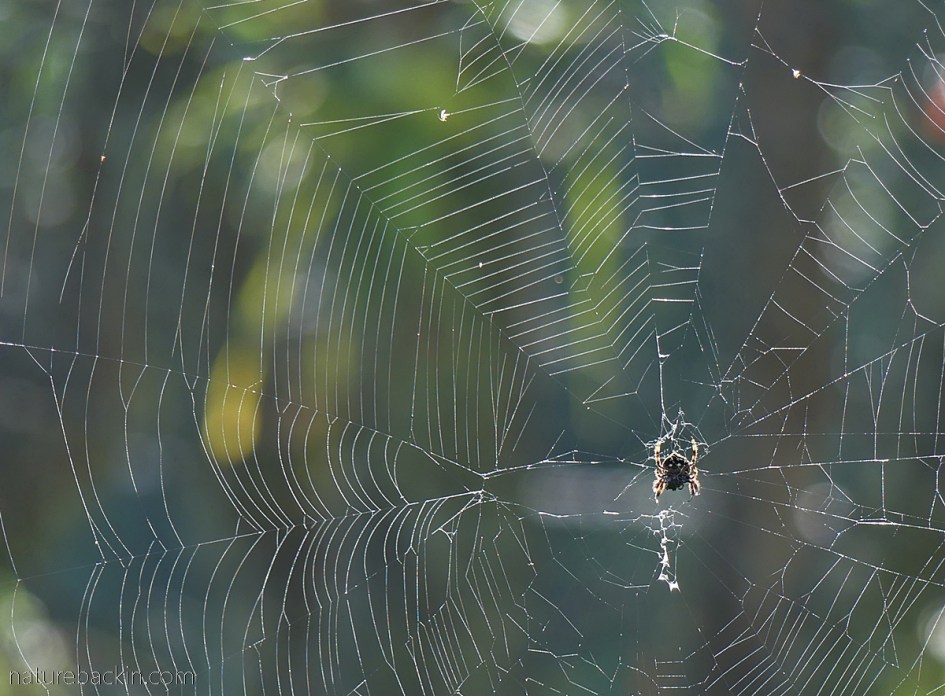
A few weeks ago, in the morning light I noticed this unidentified spider waiting in its web for prey. Unsurprisingly, a recurring theme in this post is turning out to be food and seeking food.
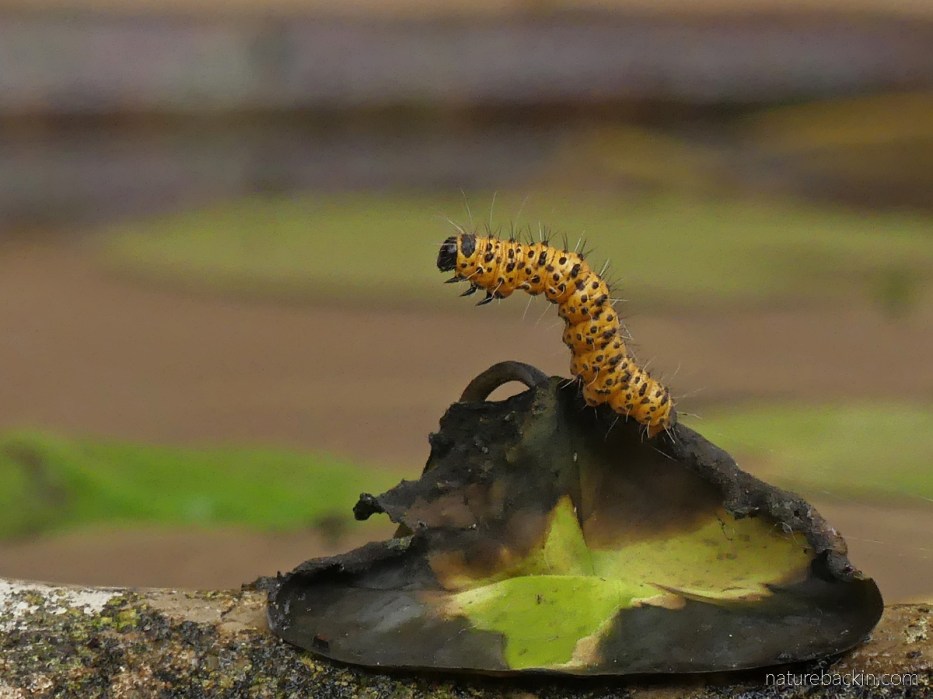
This rather handsome caterpillar was looking around from a wilted waterlily leaf perhaps for more food. The water lily plant is currently kept in isolation in a large tub of water as it turned out to be carrying string algae, which of course we didn’t want in the pond. Several caterpillars turned up to eat the lily leaves but had to move off once the leaves ran out. The lily has since sprouted a fresh crop of leaves. As I have not identified the caterpillar I don’t know if it will become a butterfly or a moth.

Of course all animals take breaks from the perpetual quest for food. Vervet monkeys often take time off in our garden or on our roofs to rest, to play or to indulge in mutual grooming sessions. In the above photo, the mother of the youngster is taking time to groom another adult monkey who is lifting his leg in a rather awkward pose.
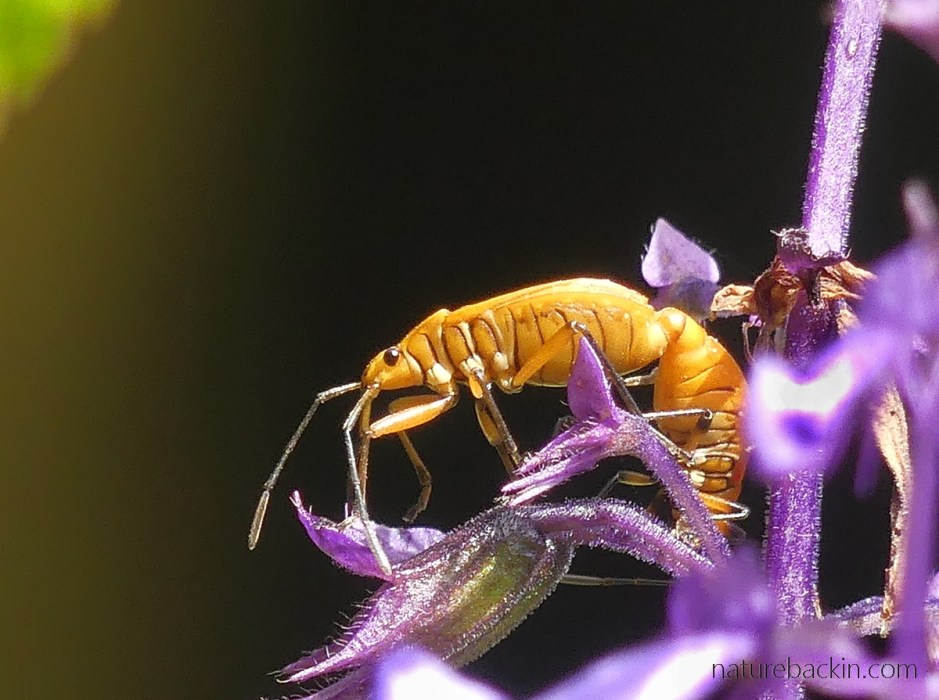
While admiring the deep blue flowers of a forest plectranthus in the garden I noticed a pair of mating bugs.
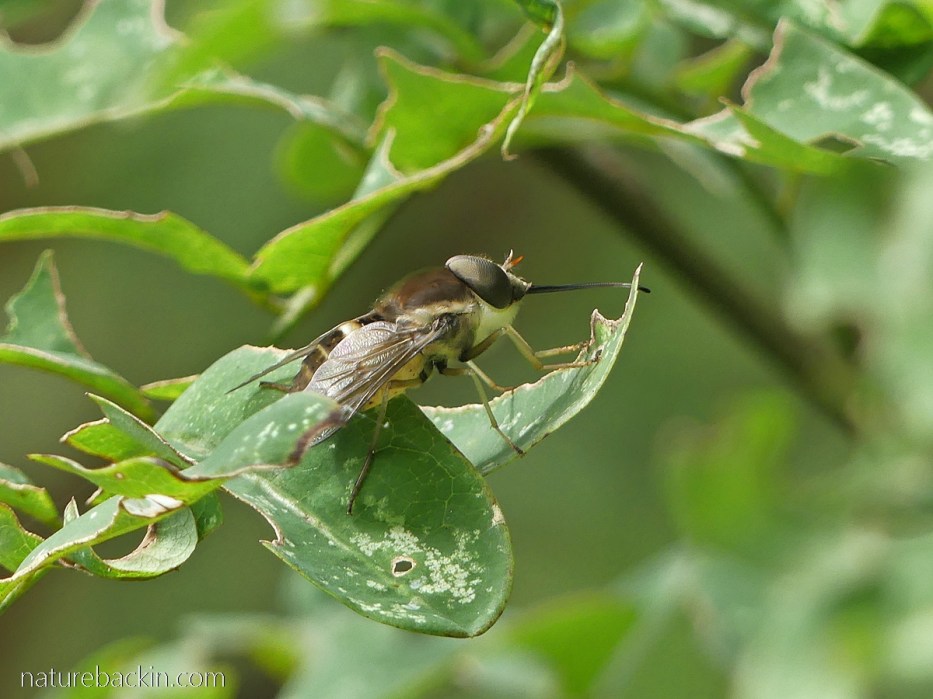
A long-tongued fly spent a long time warming up its wings in rather weak morning sunshine before taking off to find food.
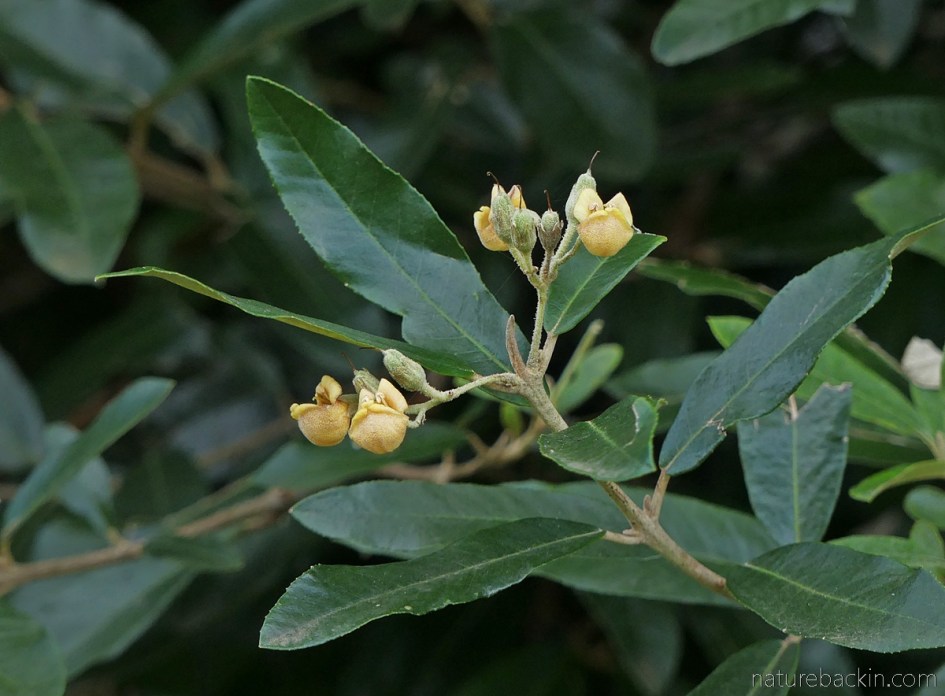
For some reason I have found it difficult to get a decent photo of the pouch-shaped pale yellow flowers of the pambati tree (Anastrabe integerrima). The pouch of the flowers opens and closes when gently pinched between finger and thumb, much like snapdragon flowers do. This attractive plant is endemic to South Africa and occurs naturally in coastal forest, forest margins and along streams in the Eastern Cape and KwaZulu-Natal.

And to return to the theme of food and foraging, here is a large wasp taking nectar from a flower on a perennial basil plant in our herb garden. The role that many species of wasps play as pollinators is often overlooked.
Well, after several weeks away with naturebackin exploring other parts of the country (i.e. posting about the different biomes), I hope you enjoyed revisiting the garden in early winter. Below is a snapshot of a kurrichane thrush stretching its wings and tail as it preened in the shade of a shrub one morning.
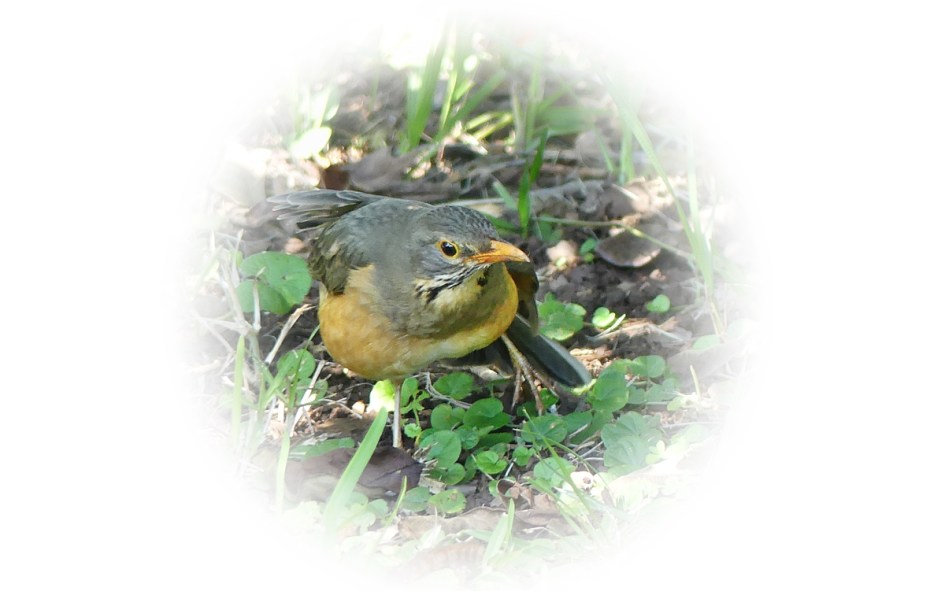
Posted by Carol

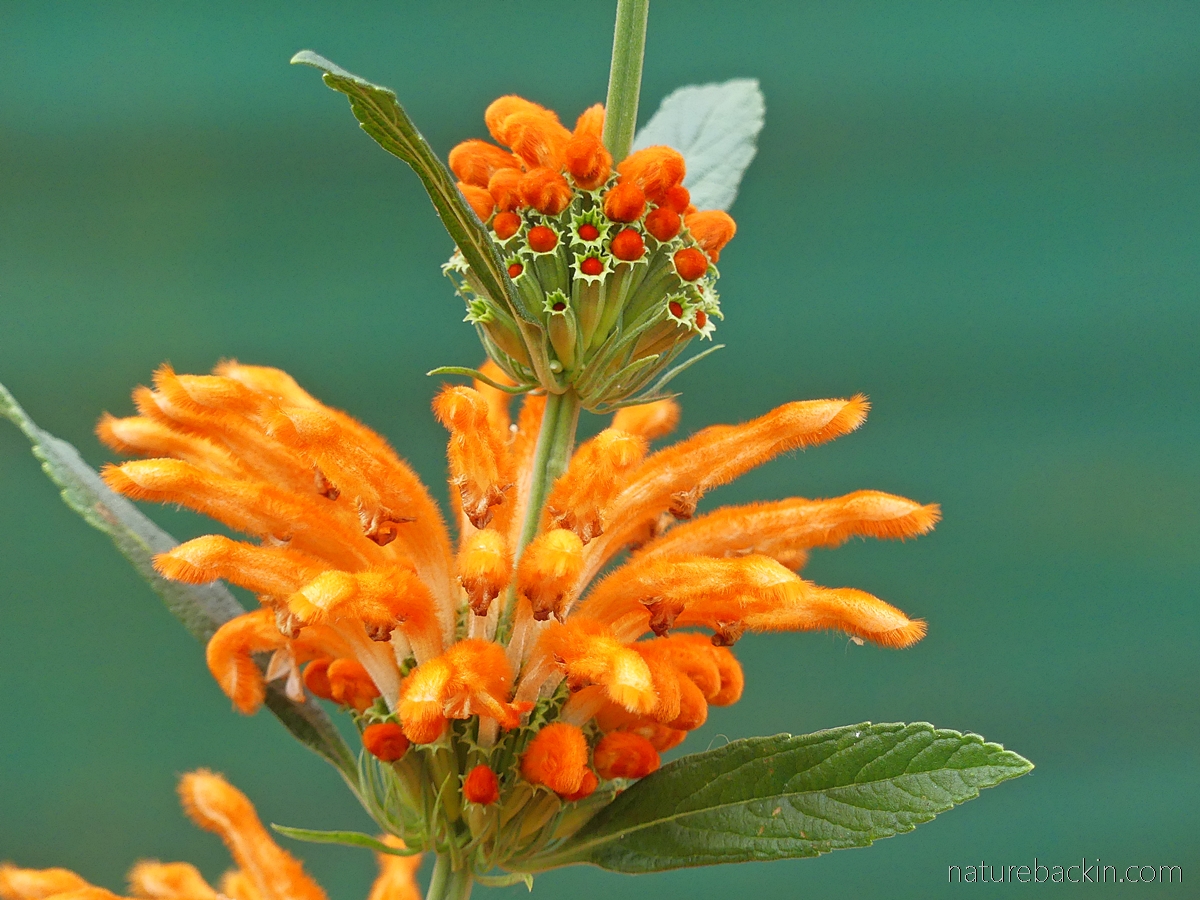







June 8, 2021 at 10:08 pm
Beautiful! I somehow missed this before. I love that the plants in your garden are totally unfamiliar to me. Thought I recognized the basil, but mine is different and annual. Berbers forever!🙊
LikeLiked by 1 person
June 10, 2021 at 5:27 pm
The annual sweet basil is a bit different to the perennial one – tastes different too!
LikeLiked by 1 person
May 28, 2021 at 8:31 am
Having been away for a few days (grandchildren! Hurray!) I’ve only just caught up with you. What a lovely gallery, so unlike anything here – well, we could manage a spider’s web of course.
LikeLiked by 1 person
May 28, 2021 at 2:42 pm
How wonderful it must have been to catch up with your grandchildren for real! I am very happy for you as the many months apart have been terribly tough.
Glad you enjoyed some of our winter flowers and the universal spider’s web too.
LikeLiked by 1 person
May 28, 2021 at 4:08 pm
They were a real treat, your flowers. As we wrestled with cancelled ferries and all sorts in our quest to get over and see Team Number Three …
LikeLiked by 1 person
May 31, 2021 at 8:33 pm
Glad the flowers were a bright spot in what sounds like a complicated journey. I do hope that you did manage to get to see Team Number Three – I assume this is the family in Barcelona with your youngest grandchild?
LikeLiked by 1 person
May 31, 2021 at 8:57 pm
Not there yet. Fingers crossed it will work out, as sailings have already been cancelled. Then there are multiple Covid tests to pay for on return to the UK….
LikeLiked by 1 person
May 31, 2021 at 9:17 pm
Tough times are continuing and not good news that infections are rising. Here too the infection rate is rising more rapidly as we are entering the third wave. My husband and I are grateful that we have received our first vaccination shots this month.
I hope things do work out for you soon though.
LikeLiked by 1 person
June 1, 2021 at 7:43 am
Oh good! So glad you’ve had Dose One. We’re all done now, but it doesn’t stop us being very careful.
LikeLiked by 1 person
June 3, 2021 at 7:25 pm
Absolutely, we have to continue to be very careful, but I do feel a strong feeling of relief.
LikeLiked by 1 person
May 24, 2021 at 9:38 am
Super photos, I love the grasshopper and the caterpillar especially.
LikeLiked by 1 person
May 24, 2021 at 8:37 pm
Thanks very much Denzil. I thought the grasshopper and the caterpillar each had quite a presence for such small creatures!
LikeLiked by 1 person
May 25, 2021 at 9:56 am
Yes, as if they knew the camera was pointing at them!
LikeLiked by 1 person
May 27, 2021 at 9:50 pm
Exactly!
LikeLike
May 22, 2021 at 9:41 pm
What a delightful post, Carol. I loved meandering through your garden, learning from you and enjoying your marvelous images. Those vibrant Dagga, the grasshopper, the berries, the kingfisher, the monkeys, the caterpillar and the mating bugs – all beautifully photographed. Thanks for taking me with you. 🙂
LikeLiked by 1 person
May 24, 2021 at 2:41 pm
Thanks so much Jane, and I really appreciate your kind words. I confess I always feel a bit like a ‘pretend’ photographer as I only use a bridge camera (since I stopped using my old SLR some years back), but I like its portability, versatility and low-light capability.
Recently I have been thinking about maybe getting a basic mirrorless camera, but then I know I will want to start adding lenses and then and then … And anyways, I still have more to learn about using the bridge camera!
LikeLiked by 1 person
May 24, 2021 at 3:59 pm
Hi Carol, I know the feeling of “imposter syndrome” well and I can reassure you that your images are beautifully seen and shot. I went mirrorless 6 years or so ago and love it for the reasons you like your bridge camera, and yes, there are many technical things in these cameras that need to be further explored!
LikeLiked by 1 person
May 24, 2021 at 8:09 pm
Thanks very much Jane 🙂 Perhaps when we can get out and about more I might want to experiment more with landscapes and will think more about a mirrorless camera then. I admire your photography immensely – and particularly enjoy your landscapes.
LikeLiked by 1 person
May 24, 2021 at 8:23 pm
Thanks so much, Carol.☺️
LikeLiked by 1 person
May 22, 2021 at 5:55 pm
I thoroughly enjoyed this tour through your garden. Thank you for showing us these sights, which you capture so beautifully through your sharp eye and the lens of your camera
LikeLiked by 1 person
May 24, 2021 at 2:34 pm
Thanks Mariss. We are so lucky to have so much going on in the garden even in the cooler and dryer months.
LikeLiked by 1 person
May 22, 2021 at 12:20 pm
I especially enjoyed the birds in your garden, Carol. I remember many of them from my visits to Mpumalanga. But the range of other plants and creatures remind me that there is always something to see and enjoy at any time of the year.
LikeLiked by 1 person
May 24, 2021 at 2:33 pm
Thanks Sandra. We get more species of birds visiting our garden in the autumn and winter months. I guess in the summer months they can disperse to wetlands or higher altitudes. Whatever the reason we are so enjoying having more bird activity in the garden. The birdbaths in particular are in high demand.
LikeLiked by 1 person
May 22, 2021 at 1:48 am
I always enjoy seeing the plants and animals in your garden, Carol, as all are so new and different to me. So much going on, even in autumn. 🙂
LikeLiked by 1 person
May 24, 2021 at 2:17 pm
Thanks Eliza – yes, we are very lucky that our winters are so mild that very little goes completely dormant.
LikeLiked by 1 person
May 21, 2021 at 2:45 pm
Lots of wonderful pictures. I loved the caterpillar one – that should have been in Alice in Wonderland.
LikeLiked by 1 person
May 21, 2021 at 8:43 pm
Thanks very much Susan. I am thinking that a hookah-smoking caterpillar fits in well with using the wild dagga as a tobacco!
LikeLike
May 21, 2021 at 9:24 am
Hi Aunty Carol
A delightful post yet again, I love all the things you post on but especially what is right in your back yard.
Thank you for bringing such cheer.
I wanted to ask about the Tassel berry tree, would it grow up in JHB? It looks to be a beautiful tree and helpful to nature. May be worth planting a couple in my garden.
Have VC a great weekend. Stay warm and safe. 🍂🍃🍁
LikeLiked by 1 person
May 21, 2021 at 1:17 pm
Thanks Debbie. I think my posts will stick around in the garden for a bit now. Luckily even in winter there is lots to bring good cheer.
Re the tassel-berry tree, unfortunately it is not frost hardy and I expect you get frost where you are?
Perhaps you’d like to look up some alternatives such as the buffalo thorn (Ziziphus mucronata), Wild peach (Kiggelaria africana), Puzzle bush (Ehretia rigida) or Wild fuchsia (Halleria lucida), which I think will all do well on the Highveld. You can check them out at https://www.plantbook.co.za/.
The SANBI site has a great search facility where you can look plants up by region and a host of other attributes – see http://pza.sanbi.org/plants/search/advanced
You have good weekend too and keep warm during the forecast chill and safe too xxx
LikeLike
May 21, 2021 at 9:20 am
Such lovely images of this very special time of year.
LikeLiked by 1 person
May 21, 2021 at 1:11 pm
Thanks very much Nikki. We are fortunate to have so many plants that flower during the winter. Keep warm this weekend!
LikeLike
May 21, 2021 at 6:23 am
After travels elsewhere (which I hope we will read about), what a wonderful garden to come home to! I have enjoyed this from start to finish and returned to have another good look at your outstanding photographs – you see a lot! Like Dries, I look forward to my Friday morning read 🙂
LikeLiked by 1 person
May 21, 2021 at 8:00 am
Thank you so much Anne, and how lovely to know that my weekly posts are enjoyed. I have been thinking of cutting back to posting fortnightly as I sometimes have trouble keeping up, but will stick with weekly for the time being.
As I said to Gunta in another comment, my comment about naturebackin exploring elsewhere was misleading. I have amended the post to explain that I meant that the posts over the past few weeks explored the different biomes (outside of the garden) and so the return to the garden is only in terms of what I have been posting about. In reality I myself have been here all the time!
LikeLiked by 1 person
May 21, 2021 at 4:10 am
Loved every single image, but my favorite was the monkey being groomed. I tried to imagine if the expression was bored or pained by the procedure. I bet your vervet monkeys are as much fun to watch as our chipmunks! We finally dared to venture out to visit the grandkids recently. What a treat that was, but once again I find myself playing catch up here at WordPress. 😏
Hoping your explorations were a treat as well.
LikeLiked by 1 person
May 21, 2021 at 7:55 am
Thanks Gunta. When being groomed some of the monkeys do seem to go into an almost trancelike state. We enjoy having the monkeys visiting. We don’t chase or feed them and they are a courteous bunch when left in peace and there are lots of plants in the garden for them to explore.
It must have been a real treat to visit your grandkids after such a long time.
I realise I expressed myself not so clearly and meant that naturebackin (not me) went exploring the various biomes over the last few weeks. I have amended the post to make it clearer.
LikeLike
May 21, 2021 at 3:39 am
Thanks for the garden tour and terrific photos as always. We have the wild dagga here, though I don’t see a lot of it, and it generally doesn’t look as good as those in your garden.
LikeLiked by 1 person
May 21, 2021 at 7:52 am
Thanks Graham. It seems that very many SA plants have made their way to Hawaii!
LikeLiked by 1 person
May 22, 2021 at 5:08 am
I think SA plants have made there way to a lot of places. You have such a great variety.
LikeLike
May 21, 2021 at 2:01 am
Your blog really is my Friday treat, Carol. Thank you!
Our Wild Daggas have grown much taller than me in only 2 years, and blogger Aletta gave me the tip to prune them back at the end of winter. They’re like a magnet for the two kinds of sunbirds that live here in suburban Garsfontein, so I really hope I don’t mess them up when I do lay in the shears.
I’m leaving now with a mental image of grasshoppers, high from munching on wild dagga leaves, dropping to the ground in fits of unexplained laughter…
LikeLiked by 1 person
May 21, 2021 at 7:51 am
We also prune back our wild dagga plants (with a little help from the vervets when they pull some stems down when getting nectar from the flowers). After the flowering phase, I stagger the pruning a bit to make it look a bit more natural and leave several stems at least to go to seed (to be cut back later) as the plants are very generous self-seeders. I dig up some of the seedlings to plant elsewhere.
You conjure up a hilarious image of happily stoned grasshoppers 🙂
LikeLiked by 1 person
May 21, 2021 at 2:32 pm
Strangely, despite hundreds of flowers and loads of pollinators, I have not seen a single seedling from our wild daggas – perhaps there’s two much competition from the established spekboom, honey suckle, bietou and plumbago around them and the pelargoniums below for any seed to flourish?
LikeLiked by 1 person
May 21, 2021 at 8:40 pm
It is quite strange but maybe there isn’t enough space for them – here in the spring the seedlings crop up all over the place and even in cracks between paving stones.
LikeLiked by 1 person
May 21, 2021 at 1:19 am
loved the caterpillar shot!
LikeLiked by 1 person
May 21, 2021 at 7:46 am
A caterpillar with attitude!
LikeLike
May 21, 2021 at 8:08 am
👍👍
LikeLiked by 1 person
May 20, 2021 at 7:59 pm
What a beautiful garden gallery this is, Carol!
LikeLiked by 1 person
May 21, 2021 at 7:46 am
Thanks so much Sandy.
LikeLiked by 1 person
May 21, 2021 at 5:47 pm
My pleasure.
LikeLiked by 1 person